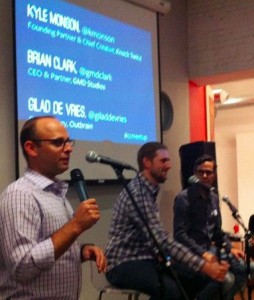Content Marketing
Content Conversations Meetup Tackles the Future for Writers and Campaigns
Content: Is it a bubble, is it a boom, will it bust? Or has it already?
The forecast question was central to the discussion at the first installment of the new Content Conversations series held at the New York offices Outbrain, on Monday. Aug. 13. The event was co-hosted by Outbrain and Contently.

Gilad de Vries, Kyle Monson and Brian Clark at Monday’s Content Conversations event.
The conversation focused on how content strategists, marketers and writers can grow in a changing marketplace.
Kyle Monson, founding partner and chief creative officer at content marketing and public relations firm Knock Twice, spoke about over-intrusive advertising, and what effects interruptive material can wreak upon intelligent content ideas.
“I get a little bit nervous sometimes when I see the content campaigns online that are being covered by Ad Age and stuff like that because I don’t think they’re very well done,” Monson said. “And I worry that today’s generation of CMOs are going to get it in their head that content campaigns are very hard to tag to metrics and to ROI. And you can burn through a generation of CMOs like that.”
When consumers walk away from clunky product pitches within poorly designed content campaigns, Monson said, executives may begin to question campaigns as a whole.
“At some point he or she is going to scratch his or head head and say, ‘Really? We’re paying a lot of money to do these campaigns. Are we really getting anything out of it?'” he said. “And if the answer is ‘no,’ as I think it will be for a lot of brands that are trying this . . . we’re going to have to innovate somehow to convince them.”
“I would make the argument that because we’re in that era,” said Brian Clark, transmedia agency GMD Studios chief executive, regarding CMOs and the perceived value of the content campaign, “that means the bubble burst a long time ago.”
Content Creators: Surviving on a Five-Dollar Deal
Clark said that an important part of the content-bubble equation is that of how creators can survive if what they make becomes increasingly devalued.
As soon as markets began to pay $5 per blog post, Clark said: “Then what? Huffington Post said: ‘We’re not even going to pay you that, but you’ll get a bonus based upon how much traffic the article brings.’
“And here we go, here comes the sinking,” Clark continued. “How does anyone do any real, rewarding work? How does anyone do any real thinking, when it’s a five-dollar blog post? And what does all of this mean for us, who want to make really great content?”
One thing it means, Clark suggested, is that creators will work where they get paid, and they’ll work where their expertise is perceived to be important.
For the moment, Monson said, that relationship is probably still found at ad agencies. And it’s a two-way street, when it comes to what each party wants. Agencies like the editorial injection.
“The ad agencies go: ‘Editorial calendar . . . what a clever idea!'”
‘Really Great Content’: Going Forward in the Post-Bubble Era
Gilad de Vries, senior vice president of strategy at Outbrain, offered a third point of view: The success of content is very much still about the promotion of great material, in whatever format it arrives.
“If you’re a content creator and you’re not thinking about how people are going to discover your content, and how they are going to engage with it once they find it — and are they going to share it — then you have a problem,” de Vries said.
“If you create your own content and then you make sure that the brand you work with is not just putting it out there and waiting or hoping for something to happen with it, then there’s a very high likelihood that your content will perform greatly for your client.”
 On that point, Clark agreed, but he also suggested that there’s a kind of Darwinian element at work, that in the post-bubble world not everybody gets to be a star.
On that point, Clark agreed, but he also suggested that there’s a kind of Darwinian element at work, that in the post-bubble world not everybody gets to be a star.
“The more democratized content creation becomes,” Clark said. “The more we have to expect that not everyone is going to be able to make a living at content creation. Just as not everyone who’s in a band makes a living at being in a band.”
Monson said that creators can survive in a post-bubble world if they bring experience, expertise, and a strong voice to the tables of the publishers with whom they work.
It was a full room, a mix of men and women of different ages. Most identified themselves as content creators of some kind, when the panelists polled them.
He asked the crowd: “How many of you are journalists or former journalists, and have those clients who have treated you like wizards who know this grand secret to publishing?”
For those who can pitch smart content that treats its audience with intelligence, he said: “I think most of us will be fine if the bubble pops.”
Or even if it has popped already, and we are living in a post-content-bubble world.
The next Content Conversations will be Sept. 19, with Outbrain CEO Yaron Galai moderating a discussion between Lewis D’Vorkin, chief product officer of Forbes Media and Annalisa Camarillo, senior manager of executive initiatives of NetApp.
Images courtesy of Erica Swallow. For more images from the event, click here.

Get better at your job right now.
Read our monthly newsletter to master content marketing. It’s made for marketers, creators, and everyone in between.




